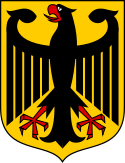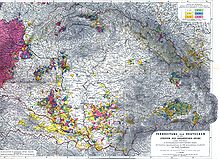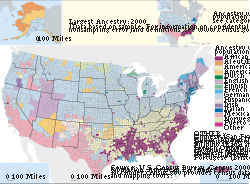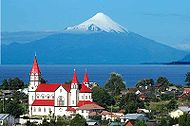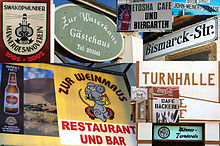- Ethnic Germans
-
- This article is about the ethnic German diaspora. See Germans Abroad for German citizens with residence abroad. See Emigration from Germany for disambiguation.
Ethnic Germans (German: Deutschstämmige, historically also Volksdeutsche), also collectively referred to as the German diaspora, refers to people who are of German ethnicity. Many are not born in Europe or in the modern-day state of Germany or hold German citizenship. They are subdivided culturally into Low German and High German categories, also the "North" and "South" Germans and furthermore into historical regions.
Contents
Terminology
Volksdeutsche "ethnic Germans" is a historical term which arose in the early 20th century and was used by the Nazis to describe ethnic Germans living outside of the German Empire, although many had been in other areas for centuries.
Auslandsdeutsche (adj. auslandsdeutsch) is a concept that connotes German citizens living abroad, or alternatively ethnic Germans entering Germany from abroad. Today, this means citizen of Germany living more or less permanently in another country (including long-term academic exchange lecturers and the like), who are allowed to vote in the Republic's elections, but who usually do not pay taxes to Germany. In a looser but still valid sense, and in general discourse, the word is frequently used in lieu of the ideologically tainted term Volksdeutsche, denoting persons living abroad without German citizenship but defining themselves as Germans (culturally or ethnically speaking).
Distribution
Ethnic Germans are a minority group in many countries. (See Germans, German language, and German as a minority language for more extensive numbers and a better sense of where Germans maintain German culture and have official recognition.) The following sections briefly detail the historical and present distribution of ethnic Germans by region, but generally exclude modern expatriates, who have a presence in the United States, Scandinavia and major urban areas worldwide. See Groups at bottom for a list of all ethnic German groups, or continue for a summary by region.
Australia
(See German Australian)
- There have been ethnic Germans in Australia since the founding of the New South Wales colony in 1788, Governor Arthur Phillip (the first Governor of New South Wales) was an ethnic German, his father was German.
The first significant wave of German immigration was in 1838. These Germans, mostly Prussian immigrants (but also winegrowers from the Hesse-Nassau state and the Rheingau). From there after, thousands of Germans emigrated to Australia until World War I. Also, German was the most identified ethnicity behind English and Irish in Australia until World War I.
After World War II, a huge number of Germans emigrated to Australia to escape the war-torn Europe.
North America
- There are over 60 million Americans of at least partial German ancestry in the United States, including various groups such as the Pennsylvania Dutch. Of these, 23 million are of German ancestry alone ("single ancestry"), and another 40 million are of partial German ancestry, making them the largest group in the United States, followed by the Irish . Of those who claim partial ancestry, 22 million identify their primary ancestry ("first ancestry") as German. The 55 million Americans of primarily German ancestry are by far the largest part of the German diaspora, a figure equal to nearly two-thirds the population of Germany itself. Germans form just under half the population in the Upper Midwest.[1][2]
- Canada (3.2 million, 10% of the population), see also German Canadians.
Latin America
They are a considerable part of the population in:
- Brazil: Mainly in Southern Brazil; about 5 million people, or 2.5% of the total population, descend from Germans who immigrated to the country from the mid-XIX century until World War II.
- Famous German-Brazilians are former military president Ernesto Geisel, politician Jorge Bornhausen, actress Vera Fischer, Cacilda Becker, top models such as Gisele Bündchen, Ana Hickmann, Letícia Birkheuer and Rodrigo Hilbert, musicians like Andreas Kisser and Astrud Gilberto, landscape architect Roberto Burle Marx, physicist and astronomer Marcelo Gleiser, physician Adolfo Lutz, basketball player Oscar Schmidt, tennis player Gustavo Kuerten, swimmer Fernando Scherer, TV host Xuxa Meneghel, Cardinals Cláudio Hummes and Paulo Evaristo Arns and the renowned sailor Robert Scheidt among many others.
- Argentina: The German embassy in Argentina estimates that 600.000 Argentines, or 1.5% of the total population, have at least partial German ancestry.[3] These two groups are more common in Southern Argentina, and also in Santa Fe and Cordoba provinces. A notable example is the town of Villa General Belgrano, founded by Germans in the 1930s. In the 1960s it became the site of the Fiesta Nacional de la Cerveza, or Oktoberfest, which has become a major attraction in Argentina[4]
- Nazi Minister Walther Darré was born in Argentina. After the Second World War, almost a thousand prominent Nazi leaders and politicians fled to Argentina. Adolf Eichmann and Josef Mengele were among them. Kurt Tank, who developed some of the greatest WWII aircraft fighters also entered Argentina in the late 40´s.[5]
- An example of German Argentines is the late president Néstor Kirchner. Other notable examples of ethnic German Argentines are top models Nicole Neumann, Milagros Schmoll, basketball player Wálter Herrmann, businessman Horst Paulmann, social leader Juan Carlos Blumberg beermakers Otto Bemberg and Otto Schneider, and football players Gabriel Heinze, Federico Lussenhoff, Gabriel Schurrer, Rene Houseman, among many others.
- Chile: 150,000 ~200,000 [3], Some notable German descendants in Chile are: Air Force General Commander Fernando Matthei Aubel, architect Mathias Klotz, tennis player Hans Gildemeister, female athlete Marlene Ahrens, Police General Commander Rodolfo Stange Ölckers, Musician Patricio Manns, Army Commanders in Chief Lieutenant General René Schneider and Division Generals Emil Körner, Economist Rolf Lüders, politicians Carlos Kuschel, Rolf Lüders Schwarzenberg, Miguel Kast and Evelyn Matthei, businessmen Horst Paulmann, Jürgen Paulmann, Werner Grob, Carlos Heller; TV presenters Karen Doggenweiler, Margot Kahl, Pamela Hodar, Michael Müller, writer César Müller (aka Oreste Plath), actresses Gloria Münchmeyer, Aline Küppenheim, actor Bastián Bodenhöfer, painter Rossy Ölckers, and publisher and orders collector Norberto Traub. There are also many German speaking Swiss, generally assumed as Germans, of whom some notable descendants are: Presidents Eduardo Frei (father and son) and Economist Hernán Büchi.[citation needed]
- Mexico (under 1 million), see German Mexicans and Mennonites in Mexico.[6] Also of note, the 'Colegio Alemán Alexander von Humboldt', or Alexander von Humboldt school in Mexico City is the largest German school outside Germany.
Notable communities of ethnic Germans exist in:
- Peru: The communities of Oxapampa, Pozuzo, and Villa Rica in the high jungles of the Peruvian Amazon basin were settled in the middle of the 19th century by Austrian and Prussian immigrants. Many of its present day inhabitants speak German[7] In the 18th century, German immigrants settled the areas of Tingo Maria, Tarapoto, Moyobamba, and the Amazonas Department.[8] German immigrants largely settled in Lima, and to a lesser extent Arequipa.[9]
- Colombia: 20,000 Germans are believed to live in Colombia, the majority are descendants other than recent immigrants.[citation needed]
- Dominican Republic: There is a colony of around 25,000 Germans who have settled in the country, mostly on the northern coast's Puerto Plata, as well as a colony of the descendants of German and Austrian Jewish refugees in Sosua.[citation needed]
- Ecuador: 32,000, counting standard German-speakers only, but an estimated 150,000 are of German ancestry.[citation needed].
- Bolivia,[10] 80,000, 40,000, and 5,763 Mennonite German speakers respectively, as well as notable (but more assimilated) public figures from various German groups. Its estimated 500,000 are of German ancestry.
- Paraguay : 100,000 speakers. An estimated 300,000 of German ancestry, including former dictator Alfredo Stroessner.[citation needed]
- Puerto Rico: 1,453 speakers[citation needed] and the island experienced a large migration of Germans in the 19th century during Spanish rule.[citation needed] (Spanish) Pozuzo Information
- Uruguay: 28,000 standard German, 1,200 Mennonite Low German.[citation needed]
- Venezuela : Around 1,300 Alemán Coloniero speakers in Colonia Tovar, Aragua. The country has 50,000 of German ancestry.[citation needed]
Western Europe and the Alpine nations
Main article: German-speaking EuropeItaly
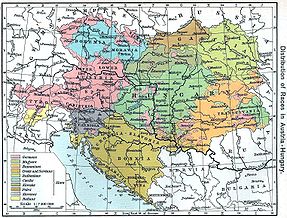 Map of Austria-Hungary in 1911, showing areas inhabited by ethnic Germans in pink
Map of Austria-Hungary in 1911, showing areas inhabited by ethnic Germans in pink
There exist smaller, unique populations of Germans who arrived so long ago that their dialect retains many archaic features heard nowhere else:
- the Cimbrians (Zimbern), though celebrated since their discovery, are relatively few in number and concentrated in various communities in the Carnic Alps, north of Verona, and especially in the Sugana valley (it:Valsugana or Suganertal) on the high plateau northwest of Vicenza in the Veneto Region
- the Walser, who originated in the Swiss Wallis, live in the provinces of Aostatal, Vercelli, and Verbano-Cusio-Ossola
- the Mócheno live in the Fersina Valley (it:Valle dei Mocheni)
Smaller German-speaking communities exist also in the Friuli Venezia Giulia region: the Carinthians in the Canale Valley (municipalities of Tarvisio, Malborghetto Valbruna and Pontebba) and the Zahren and Timau Germans in Carnia.
Contrarily to the before-mentioned minorities, the German speaking population of the province of South Tyrol cannot be categorized as “ethnic German” according to the definition of this article, but as Austrian minority.[11] The province formerly was part of the Austrian County of Tyrol before the 1919 dissolution of the Austro-Hungarian Empire. South Tyrolians were part of the over 3-million German speaking Austrians who in 1918 found themselves living outside of the newborn Austrian Republic as minorities in the newly formed or enlarged respective states of Czechoslovakia, Yugoslavia, Hungary and Italy. Their dialect of South Tyrolians is Austro-Bavarian German. Both standard German and dialect are used in schooling and media. German enjoys co-official status with the national language of Italian throughout this region.
Alpine nations
Austria, Switzerland, and Liechtenstein each have a German-speaking majority, though the vast majority of the population do not identify themselves as German. Starting during World War II and later assisted by the Allied Forces, Austrians discovered and developed a distinct national identity. Thus, the Austrian nation is a relatively young one.[12][13][14] In addition, an estimated 112,000 German nationals live in Switzerland; another 110,000 live in Austria.
Benelux
Belgium
In Belgium, there is an ethnic German minority. It is the majority in its region of 71,000 inhabitants. Ethnologue puts the national total of German speakers at 150,000, not including Limburgisch and Luxembourgish).
Luxembourg
Though their language (Luxembourgish) is closely related to the German language, Luxembourgers do not consider themselves ethnic Germans. In a 1941 referendum held in Luxembourg by ethnic German residents, more than 90% proclaimed themselves Luxembourgish by nationality, mother tongue and ethnicity.[15]
Denmark
In Denmark, the part of Schleswig that is now South Jutland County (or Northern Schleswig) is inhabited by about 12,000–20,000 ethnic Germans [16] They speak mainly Standard German and the South Jutlandic. A few speak Schleswigsch, a Northern Low Saxon dialect.
United Kingdom
In the United Kingdom, there exists a German-Briton ethnic group of around 300,000. Some are descended from nineteenth century immigrants. Others are 20th century immigrants and their descendants: German-Jews who fled Nazi Germany in the 1930s (and are unlikely to identify first as ethnic Germans), and World War II prisoners of war held in Great Britain who decided to stay there. Others arrived as spouses of British soldiers from post-war marriages in Germany, when British were occupying forces. Many of the more recent immigrants have settled in the London and southeast part of the United Kingdom, in particular, Richmond (South West London).
The British Royal Family are partially descended from German monarchs.
Central and Eastern Europe and the former Soviet Union
See also: German eastward expansion, History of German settlement in Eastern Europe, Organised persecution of ethnic Germans, and German exodus from Eastern Europe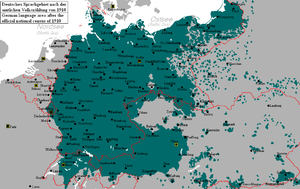 German language area in 1910–11, the boundaries of states are in red. Pan-German nationalists wanted to unite much of the green areas into one German nation-state.
German language area in 1910–11, the boundaries of states are in red. Pan-German nationalists wanted to unite much of the green areas into one German nation-state.
From Celtic times the early Germans settled from the Baltic all the way to the Black Sea until the great migrations of the 4-6th century AD. Germans migrated again eastwards during the medieval period Ostsiedlung until the Expulsion of Germans after World War II; many areas in Central and Eastern Europe had an ethnic German population. In the Middle Ages, Germans were invited to migrate to Poland and the central and eastern regions of the Holy Roman Empire and also the Kingdom of Hungary following the Mongol invasions of the 12th century, and then once again during the late 17th century after the Austrian-Ottoman wars to set up farms and repopulate the eastern regions of the Austrian Empire and Balkans.
The Nazi government termed such ethnic Germans Volksdeutsche, regardless of how long they had been residents of other countries. Now they would be considered Auslandsdeutsche). After World War II, in reaction to the Nazi concepts, eastern European nations such as Poland, the Czech Republic, Slovakia, Hungary, Soviet Union and Yugoslavia expelled or murdered ethnic Germans living in their territories.
There were significant ethnic-German populations in such areas as Romania, Moldova, and Ukraine at one time. As recently as 1990, there were one million standard German speakers and 100,000 Plautdietsch speakers in Kazakhstan alone[citation needed], and 38,000, 40,000 and 101,057 standard German speakers in Ukraine, Uzbekistan, and Kyrgyzstan, respectively.[citation needed]
There were reportedly 500,000 ethnic Germans in Poland in 1998.[17] Recent official figures show 147,000 (as of 2002)[4]. Of the 745,421 Germans in Romania in 1930,[18] only about 60,000 remain.[19] In Hungary the situation is quite similar, with only about 220,000.[20] There are up to one million Germans in the former Soviet Union, mostly in a band from southwestern Russia and the Volga valley, through Omsk and Altai Krai (597,212 Germans in Russia, 2002 Russian census) to Kazakhstan (353,441 Germans in Kazakhstan, 1999 Kazakhstan census). Germany admitted approximately 1.63 million ethnic Germans from the former Soviet Union between 1990 and 1999.[21]
These Auslandsdeutsche, as they are now generally known, have been streaming out of the former Eastern Bloc since the early 1990s. For example, many ethnic Germans from the former Soviet Union have taken advantage of the German Law of Return, a policy which grants citizenship to all those who can prove to be a refugee or expellee of German ethnic origin or the spouse or descendant of such a person. This exodus has occurred despite the fact that many of the ethnic Germans from the former Soviet Union were highly assimilated and spoke little or no German.
Baltic states
Main article: Baltic GermansFurther information: Nazi-Soviet population transfersBulgaria
Main article: Germans in BulgariaCzech Republic and Slovakia
Main articles: Germans in the Czech Republic and Germans from SlovakiaBefore World War II, some 30% of the population in the Czech lands were ethnic Germans, and in the border regions and certain other areas they were even in the majority.[22] There are about 40,000 Germans in the Czech Republic (number of Czechs who have at least partly German ancestry probably runs into the hundreds of thousands).[23] Their number has been consistently decreasing since World War II. According to the 2001 census there remain 13 municipalities and settlements in the Czech Republic with more than 10% Germans.
The situation in Slovakia was different from that in the Czech lands, in that the number of Germans was considerably lower and that the Germans from Slovakia were almost completely evacuated to German states as the Soviet army was moving west through Slovakia, and only a fraction of those who returned to Slovakia after the end of the war were deported with the Germans from the Czech lands.
Many representatives of expelee organizations support the erection of bilingual signs in all formerly German-speaking territory as a visible sign of the bilingual linguistic and cultural heritage of the region. The erection of bilingual signs is permitted if a minority constitutes 10% of the population.
Further information: Sudeten Germans, Carpathian Germans, and Expulsion of Germans from CzechoslovakiaHungary
Main article: Germans of HungaryPrior to World War II, approximately 1.5 million Danube Swabians lived in Hungary, Romania and Yugoslavia.[24] Today the German minority in Hungary have minority rights, organisations, schools and local councils, but spontaneous assimilation is well under way. Many of the deportees visited their old homes after the fall of the Iron Curtain in 1990.
Further information: Danube SwabiansPoland
Main article: German minority in PolandMain article: WalddeutscheThe remaining German minority in Poland (152,897 people were registered in the 2002 census) enjoys minority rights according to Polish minority law. There are German speakers throughout Poland, and most of the Germans live in the Opole Voivodship in Silesia. Bilingual signs are posted in some towns of the region. In addition, there are bilingual schools and German can be used instead of Polish in dealings with officials in several towns.
Further information: Bilingual communes in Poland, Former eastern territories of Germany, Olędrzy, Vistula Germans, and Flight and expulsion of Germans from Poland during and after World War IIRomania
Main article: Germans of RomaniaFurther information: Transylvanian Saxons, Banat Swabians, Transylvanian Landler, and Expulsion of Germans from Romania after World War IIFormer Soviet Union
Main article: History of Germans in Russia and the Soviet UnionFurther information: Black Sea Germans, Bessarabia Germans, Bukovina Germans, Crimea Germans, Germans of Kazakhstan, Caucasus Germans, Russian Mennonite, and Volga GermansFormer Yugoslavia
Main article: Germans of YugoslaviaAccording to the 1921 census, the German community was the largest minority group in the Kingdom of Yugoslavia (505,790 inhabitants or 4.22%).[25]
Africa, Oceania, and Asia
During the long decline of the Roman Empire and the ensuing great migrations German tribes such as the Vandals (who sacked Rome) migrated into North Africa and settled mainly in the lands corresponding to modern Tunisia and northeastern Algeria.
Germany was not as involved in colonizing Africa as other major European powers of the 20th century (principally because Germany was not a unified country prior to 1871), and lost its overseas colonies, including German East Africa and German South-West Africa, after World War I. Similarly to those in Latin America, the Germans in Africa tended to isolate themselves and be more self-sufficient than other Europeans. In Namibia there are 30,000 ethnic Germans, though it is estimated that only a third of those retain the language. Most German-speakers live in the capital, Windhoek, and in smaller towns such as Swakopmund and Lüderitz, where German architecture is highly visible.
In South Africa, a number of Afrikaners and Boers are of partial German ancestry, being the descendants of German immigrants who intermarried with Dutch settlers and adopted Afrikaans as their mother tongue. Professor JA Heese in his book Die Herkoms van die Afrikaner (The Origins of Afrikaners) claims the modern Afrikaners (who total around 3.5 million) have 34.4% German heritage.[26]
Like North America, Australia has received a significant number of ethnic-German immigrants from Germany and elsewhere. Numbers vary depending on who is counted, but moderate criteria give an estimate of 750,000 (4% of the population). The first wave of German immigration to Australia began in 1838, with the arrival of Prussian Lutheran settlers in South Australia (see German settlement in Australia). After the Second World War, Australia received a large influx of displaced ethnic Germans. In the 1950s and 1960s, German immigration continued as part of a large post-war wave of European immigration to Australia.
New Zealand has received modest, but steady, ethnic German immigration from the mid-19th century. Today the number of New Zealanders with German ancestry is estimated to be approximately 200,000 (5% of the population). Many German New Zealanders anglicized their names during the 20th century due to the negative perception of Germans fostered by World War I and World War II. New Zealanders of German descent include the late former Prime Minister David Lange (
 /ˈlɒŋi/ long-ee). The vast majority of Germans in New Zealand settled in the North Island. Cities such as Tauranga, Hastings and, to a lesser extent, Auckland have been influenced by German culture and values.
/ˈlɒŋi/ long-ee). The vast majority of Germans in New Zealand settled in the North Island. Cities such as Tauranga, Hastings and, to a lesser extent, Auckland have been influenced by German culture and values.During the Meiji era (1868–1912), many Germans came to work in Japan as advisors to the new government. Despite Japan's isolationism and geographic distance, there have been a few Germans in Japan, since Germany's and Japan's fairly parallel modernization made Germans ideal O-yatoi gaikokujin.
In China, the German trading colony of Jiaozhou Bay in what is now Qingdao existed until 1914, and did not leave much more than breweries, including Tsingtao Brewery.
Smaller numbers of ethnic Germans settled in the former Asian territories of Malaysia (British), Indonesia (Dutch) and the Philippines (American) in the late 19th and early 20th centuries.[citation needed] In Indonesia, some of them became well-known figures in history, such as C.G.C. Reinwardt (founder and first director of Bogor Botanical Garden), Walter Spies (German of Russian origin, who became the artist that made Bali known to the world), and Franz Wilhelm Junghuhn (owner of a big plantation in the south of Bandung and dubbed "the Humboldt of the East" because of his ethno-geographical notes).
Members of the German religious group known as Templers settled in Palestine in the late 19th Century and lived there for several generations, but were expelled by the British from Mandatory Palestine during World War II, due to pro-Nazi sympathies expressed by many of them.
Communist East Germany had relations with Uganda and Vietnam, but in these cases population movement went mostly to, not from, Germany. After the German reunification, a large percentage of "guest workers" from Communist nations sent to East Germany returned to their home countries.
See also: German colonial empire and List of former German colonies
Groupings
Note that many of these groups have since migrated elsewhere. This list simply gives the region with which they are associated, and does not include people from countries with German as an official national language, which are:
- Austria, Belgium, Germany, Liechtenstein, Luxembourg and Switzerland.
In general, it also omits some collective terms in common use defined by political border changes where this is antithetical to the current structure. Such terms include:
- Ungarndeutsche / Germans of Hungary.
- Serbiendeutsche / Germans of Serbia.
- Rumäniendeutsche / Germans of Romania.
Roughly grouped:
- Germans in the Czech Republic, notably:
- Sudeten Germans in the Sudetenland.
- Germans of East Prussia (the largest group), including
- Germans of Poland; see also:
- those from Lithuania: Prussian-Lithuanians and Baltic Germans.
- Baltic Germans of Latvia and Estonia, Prussian-Polonians, Prussian Latvians, and ethnic Germans in Belarus.
- The German-Briton group of the United Kingdom (sometimes called British Germans), and German Poles living in the UK since the end of WWII.
- Schleswigsch Germans in South Jutland County, Denmark.
- German-speaking citizens of the Netherlands (386,200 - 2.37% of the population), including Limburger Germans.
- German-speaking Belgians, mostly in the German-speaking Community of Belgium (DGB - Deutschsprachige Gemeinschaft Belgiens), and about 1 to 3 percent of Belgians speak German.
- South Tyrol, a majority in this province of Italy.
- Walser originally from Wallis in Switzerland, now in Italy.
- Cimbrians in Italy.
- Móchenos in Italy.
- Germans in Slovenia: in the Gottschee County, in the Lower Styrian towns of Maribor, Celje and Ptuj, and in the Apače area.
- the Bruderhof Communities.
- the original Hutterites.
- Russian Mennonites in Ukraine, including the Mennonite Brethren.
- Transylvanian Saxons in Romania.
- Transylvanian Landler Protestants in Romania.
- Carpathian Germans in Romania, as well as nearby Hungary, Slovakia and Ukraine.
- Zipser, from Spiš (Carpathian German heartland) to northern Romania.
- Regat Germans in southern and eastern Romania.
- Danube Swabians, including:
- those in the Bačka.
- Banat Swabians in the Serbian and Romanian Banat, as well as a handful in Bulgaria.
- Satu Mare Swabians in Romania, a much smaller colony as a result of the two world wars and the Communist era.
- most Germans of Hungary (especially Swabian Turkey).
- in Croatia (where it is a recognized minority language).
- and Bosnia and Herzegovina, though are now miniscule in number since WWII.
- Black Sea Germans in southern Ukraine, Moldova, Romania and Bulgaria including:
- Germans of the Crimea.
- Dobrujan Germans of Romania and Bulgaria.
- Bukovina Germans from Bukovina.
- Bessarabia Germans roughly from what is now Moldova.
- German Russians, estimated at 5 million throughout Russia, and German Ukrainians, included in Ukraine.
- Caucasus Germans (also Swabians) in the northern Caucasus, Georgia, and Azerbaijan.
- the rest of the Germans in the former USSR, including:
- Bosporus Germans, originally craftsmen in and around Istanbul, Turkey.
- Cyprus has a German expatriate community.
- Israel, many happen to be Jewish holocaust survivors.
In the Americas, one can divide the groups by current nation of residence:
- German Canadians and German-Americans, the largest ethno-ancestral group in the USA documented by the 2000 United States Census.
- Texas Germans (see also the List of German Texans).
- Hutterites who speak Hutterite German.
- German Mexicans, including Mennonites in Mexico as well as many notable figures, see German-, Austrian-, Hungarian-, and Polish- subcategories of European Mexicans, esp. in the Northern states.
- Deutschbrasilianer in Brazil, whose various languages comprise Brazilian German.
- German Argentines with prominent personalities and a notable German impact on Argentine culture.
- German-Chilean with prominent personalities and a notable impact in Southern Chile.
- Germans of Paraguay.
- Germans, mostly from outside the borders of Germany, in the rest of Latin America, especially:
- German-Puerto Ricans
- Peru, not many are German speakers, see German Peruvian.
- Uruguay, known for a German community.
- Venezuela, for example Colonia Tovar, where Alemán Coloniero is spoken.
- Colombia, Cuba and the Dominican Republic.
- Central America.
…or by ethnic or religious criteria:
- Pennsylvania Dutch
- Amish found in the USA, notably Ohio, Pennsylvania, Indiana and New York.
- Volga Germans and Plautdietsch-speaking Russian Mennonites.
- in Canada, (e.g. Chortitzer Mennonite Conference).
- in the United States, for instance in Kansas, New York State, and Chicago, Illinois where millions of residents self-claim to be German (American).
- throughout Latin America, most notably in Mexico.
- Hutterites who speak Hutterite German.
- the Bruderhof Communities, the USA and Paraguay.
In Africa, Oceania, and East Asia
- Germans of Namibia, Togo, Cameroon, Tanzania and South Africa, which was never a pre-WWI German colony.
- German Australians and German New Zealanders.
- Germans in the colony of Jiaozhou Bay, China, who founded (among others) the Tsingtao Brewery in today's Qingdao.
- Small numbers of German expatriates in East Asia (Burma, Hong Kong, Indonesia, Japan, Malaysia, Philippines, Taiwan, Thailand and South Korea).
- German cultural traits remain in Papua New Guinea.
See also
- Germans
- Germanic peoples
- Imperial Germans
- Volksdeutsch
- Auslandsdeutsch
- Pan-Germanism
- Völkisch movement
- German question
- Unification of Germany
- German as a minority language
- German dialects
- German language
- German exodus from Eastern Europe
- Expulsion of Germans after World War II
- German language in Europe
Notes
Most numbers are from the www.ethnologue.com (see See also), apart from a few from German language and Germans, as well as the following in-line citations:
- ^ Who's Counting? The 1990 Census of German-Americans. On the site of The Tricentennial Foundation German American Community Service. Accessed 12 February 2006.
- ^ Contents of ANCESTRY Table on the site of the United States Census Bureau. Accessed 12 February 2006.
- ^ http://web.archive.org/web/20100213071340/http://www.embajada-alemana.org.ar/culturas/becas1.htm
- ^ Fiesta de La Cerveza - Oktoberfest Argentina - Villa General Belgrano
- ^ Argentine Files Show Huge Effort to Harbor Nazis
- ^ "The Mennonite Old Colony Vision: Under siege in Mexico and the Canadian Connection" (PDF). http://www.hshs.mb.ca/mennonite_old_colony_vision.pdf. Retrieved 2007-05-30.
- ^ Peruano-alemán
- ^ POZUZO. Historia - caractersiticas generales - Antecedentes Caminos y vias :: antecedentes historicos clima flora y fauna posuso pozuso posuzo
- ^ [1]
- ^ Bolivian Reforms Raise Anxiety on Mennonite Frontier, New York Times
- ^ [2]
- ^ http://gratzfeld.twoday.net/topics/Austrian+Identity/
- ^ http://derstandard.at/3261105
- ^ http://www.photoglobe.info/ebooks/austria/cstudies_austria_0070.html
- ^ cf. the article on the Luxemburgish language on the German Wikipedia
- ^ http://www.uoc.es/euromosaic/web/document/alemany/an/i2/i2.html
- ^ Ethnologue report for Poland
- ^ German Population of Romania, 1930-1948
- ^ German minority
- ^ German in Hungary
- ^ German and Jewish migration from the former Soviet Union to Germany
- ^ Liberation - Post War Changes
- ^ Ethnic German Minorities in the Czech Republic, Poland and Slovakia
- ^ "History of German Settlements in Southern Hungary" by Sue Clarkson
- ^ UNDP Human Development Report for Serbia 2005
- ^ How 'Pure' was the Average Afrikaner?
External links
Ethnologue entries:
- Standard German
- Plautdietsch
- German-American Heritage Foundation of the USA in Washington, DC
- http://germanfast.blogspot.com
- Reassessing what we collect website – German London History of German London with objects and images
German people Historical 
Diaspora EuropeTransylvanian Saxons / Landler · Danube / Banat / Satu Mare Swabians · Dobruja · Zipser · Regat · Bessarabia · BukovinaElsewhereCzech Republic (Sudetenland) · Hungary · Bessarabia · Poland · Russia (Volga · Russian Mennonite) · Slovakia · Slovenia (Gottschee County) · Ukraine (Black Sea · Bukovina · Crimea)Balkans and SoutheasternElsewhereArgentina · Bolivia · Brazil · Canada (Hutterites) · Chile · Cuba · Jamaica · Mexico · Paraguay · Peru · United States (Pennsylvania Dutch · Texas · Palatines · Puerto Rico)AfricaNamibia · South Africa (Afrikaners)AsiaOceaniaSee also Categories:- German diaspora
Wikimedia Foundation. 2010.


